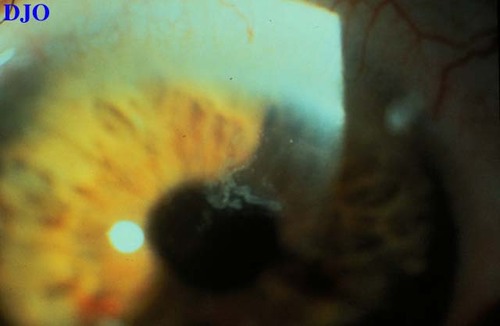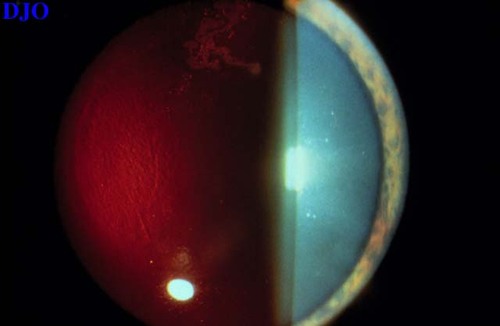Cornea/Refractive Surgery Quiz 23: Refractive Surgery

Figure 1
Figures 1-2. This patient had LASIK in this eye one week prior to these photographs. The patient has 20/20 vision without correction and is asymptomatic. Photographs courtesty of Sonia Yoo M.D.
Figures 1-2. This patient had LASIK in this eye one week prior to these photographs. The patient has 20/20 vision without correction and is asymptomatic. Photographs courtesty of Sonia Yoo M.D.

Figure 2
Answer: Epithelial ingrowth underneath the lamellar flap.
2. What are risk factors for the development of this finding?
Answer: A peripheral epithelial defect caused at the time of surgery increases the risk of epithelial ingrowth. Patients with map-dot-fingerprint dystrophy are at especially high risk for developing an epithelial defect during LASIK because of their loose corneal epithelium. An improperly aligned flap and flap striae will also increase the likelihood of ingrowth. Perforation of the flap will also predispose to epithelial ingrowth as well.
3. What percent of LASIK cases SHOW this finding?
Answer: Approximately 2% of patients will have epithelial ingrowth following a LASIK procedure.
4. What are potential complications which may arise FROM this clinical finding?
Answer: Epithelial ingrowth may induce regular and irregular astigmatism with resulting decreased vision. Epithelial ingrowth may also result in melting of the flap.
5. What is the most appropriate treatment for this lesion?
Answer: Small amounts of epithelial ingrowth in the corneal periphery (less or equal than 2 mm in diameter) require close observation to see if there is any growth. In the above patient, the ingrowth was observed and no extension occurred. For larger amounts of ingrowth or ingrowth which is increasing in size or producing a flap melt, the corneal flap should be lifted and both the stromal bed and the flap should be scraped clean of epithelium. The flap can then be put back in place. This type of maneuver may prevent further ingrowth and prevent flap melt.